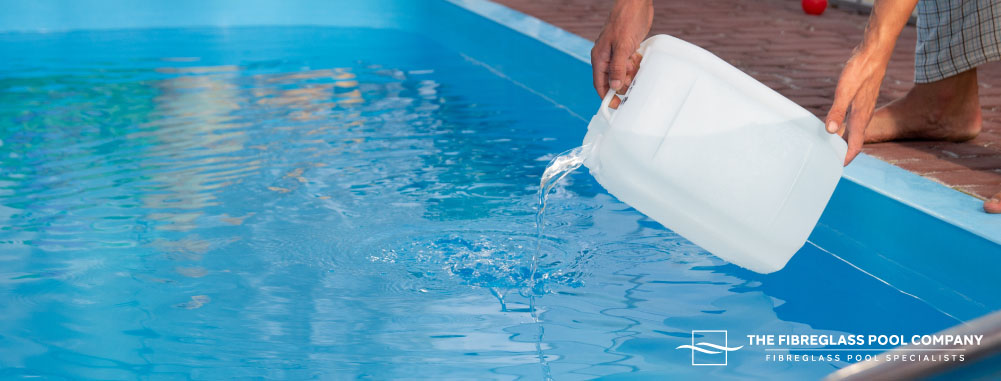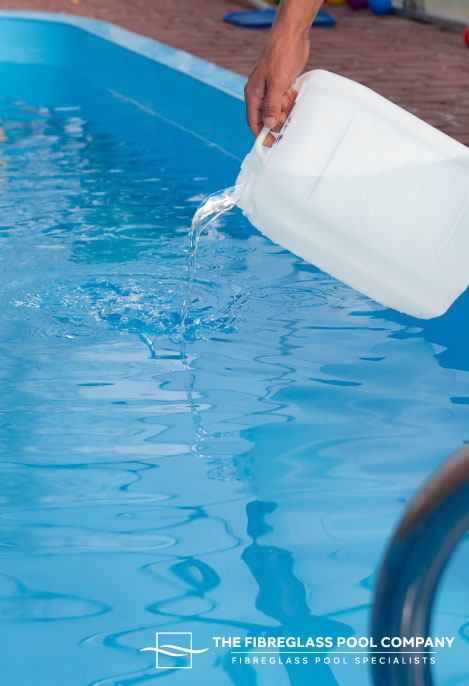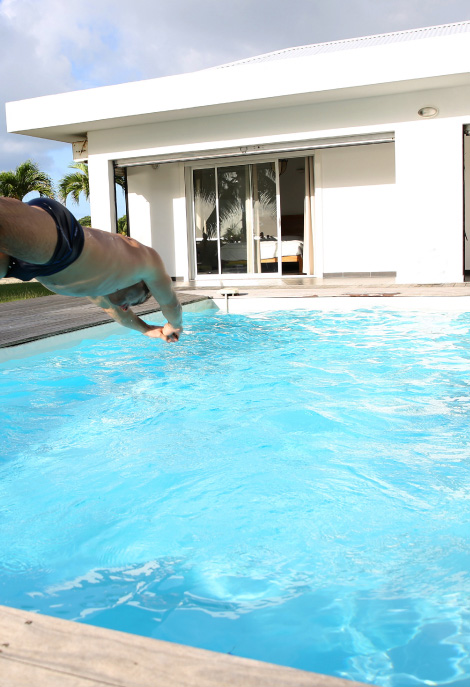Maintaining a swimming pool isn't easy. Sanitising your swimming pool is essential to keep it clean and prevent the growth of algae and bacteria. Chlorine is the most popular sanitising agent for swimming pools. However, bromine is also a good option, and many people are now considering bromine instead of chlorine to sanitise their swimming pools. Should you use bromine instead of chlorine to sanitise your pool? The answer depends on several factors like your budget, geographical location, easy availability of bromine, and the type of pool. In this guide, we'll compare bromine vs chlorine for pool sanitisation and discuss which you should use.

Bromine for pool sanitisation
Bromine is a chemical that kills contaminants through a process called ionisation. Ionisation breaks apart pollutants by attacking and breaking them apart. Bromine produces bromamine molecules that continue to sanitise your pool even after the ionisation process is over. The continued action of bromine is a huge advantage compared to using chlorine for pool sanitisation.
With a chlorine-free pool shock, you can reactivate the bromine present in the pool and return it to its full strength. Bromine is available in granular form and tablets. In addition, bromine takes a long time to dissolve in water. As a result, it takes a longer time to form a residual in the swimming pool. This also creates a problem. If the bromine level in your pool drops suddenly, it will be difficult to raise it quickly. The only solution is to use a bromine booster that can instantly increase the bromine level in your pool.
The ideal bromine level for a swimming pool is 2.0–4.0 ppm.
Chlorine for pool sanitisation
Chlorine is much more common than bromine for pool sanitisation. Unlike bromine, chlorine is an oxidising sanitiser. Once you add chlorine to your pool, it targets contaminants and kills them through oxidisation. More specifically, chlorine penetrates pollutants and breaks apart their electron particles. A residual product called chloramine is left in the pool after the oxidisation process.
Unlike bromine, chlorine doesn’t provide continued sanitisation. In fact, chlorine becomes weaker over time, and its ability to kill pollutants decreases. Residual chloramine increases over time, and it reduces the amount of Free Available Chlorine.
Free Available Chlorine is the active molecule responsible for sanitising the pool. Once the chloramine level in your pool exceeds the Free Available Chlorine level, you must shock your pool to increase the levels of Free Available Chlorine again.
Chlorine produces a strong, unpleasant smell after sanitisation. Contrary to popular belief, a stronger stench doesn’t mean your chlorine is working more effectively. It’s the opposite. A stronger stench means there’s too much chloramine in your pool, which isn’t a good thing from a sanitisation perspective.
Chlorine is available in tablets, sticks, and granules. You can use a floating dispenser, an in-line chlorinator, or an off-line chlorinator to sanitise your pool with chlorine. The ideal chlorine level for swimming pools is 2.0–4.0 ppm.

Advantages of bromine for pool sanitisation
Here are the main advantages of bromine for pool sanitisation:
- Bromine works continuously even after application. It keeps your swimming pool clean for a long time. Unlike chloramine, bromamine molecules continue to work after the ionisation process and keep your pool clean and sanitised.
- Bromine doesn’t irritate the skin or eyes. Chlorine, on the other, can cause irritation in the skin and eyes. Some people may also develop skin infections due to chlorine present in swimming pools, though it’s rare.
- Bromine doesn’t create a strong stench. It’s odourless and continues to be odourless long after application. It creates a more pleasant environment for indoor and private pools.
- A bromine shock can regain its strength and continue to sanitise your pool.
Many pool owners go for bromine instead of chlorine for these advantages. However, bromine isn’t without its cons.
Disadvantages of bromine for pool sanitisation
Here are the main disadvantages of bromine:
- Bromine is much more expensive than chlorine, typically twice as much as chlorine for the same amount. The high cost of bromine makes it an unpopular choice among commercial pool owners or those on a budget.
- Sanitising a pool with bromine takes longer than with chlorine. It might be a problem when you don’t have a lot of time to spare for sanitisation.
- It takes longer to increase or decrease bromine levels in a swimming pool. In contrast, chlorine levels can be increased or decreased quickly.
- Bromine isn’t compatible with stabilisers or conditioners, which means it doesn’t work under direct sunlight. To use bromine in outdoor pools, you have to cover the entire pool before application.

Bromine vs Chlorine: Which should you use to sanitise your pool?
Both bromine and chlorine are effective pool sanitisation agents. There are pros and cons to both, and what you choose depends on your budget, needs, and limitations.
Choose bromine over chlorine if:
- Budget isn’t a limitation for you
- You have an indoor pool or provision to cover the entire pool during sanitisation
- You cannot tolerate the odour of chlorine
- You want a long-term solution and don’t want to sanitise the pool often
- You can perform regular chlorine-free pool shocks
However, bromine may not be a good option if these criteria don’t apply to you. In that case, go for chlorine instead. It’s cheaper, easier to use, works faster, and is available everywhere.
Chlorine’s odour and skin irritation are, however, two big drawbacks. Don’t settle for chlorine if it leads to eye and skin irritation.
Conclusion
Should you use bromine instead of chlorine? The answer completely depends on your needs. However, it’s undeniable that bromine is a better choice if you can have time and money to spare. The availability of bromine may be a problem for some people, but it’s also widely available.
Despite its disadvantages, chlorine is the most popular chemical to sanitise swimming pools. It’s cheap, available everywhere, and easy to use. However, it can also irritate the skin and eyes and is bad for your hair.
As you can see, there are pros and cons to both. You can use bromine instead of chlorine if its pros outweigh its cons for your use case.
Maintaining a swimming pool isn't easy. Sanitising your swimming pool is essential to keep it clean and prevent the growth of algae and bacteria. Chlorine is the most popular sanitising agent for swimming pools. However, bromine is also a good option, and many people are now considering bromine instead of chlorine to sanitise their swimming pools. Should you use bromine instead of chlorine to sanitise your pool? The answer depends on several factors like your budget, geographical location, easy availability of bromine, and the type of pool. In this guide, we'll compare bromine vs chlorine for pool sanitisation and discuss which you should use.

Bromine for pool sanitisation
Bromine is a chemical that kills contaminants through a process called ionisation. Ionisation breaks apart pollutants by attacking and breaking them apart. Bromine produces bromamine molecules that continue to sanitise your pool even after the ionisation process is over. The continued action of bromine is a huge advantage compared to using chlorine for pool sanitisation.
With a chlorine-free pool shock, you can reactivate the bromine present in the pool and return it to its full strength. Bromine is available in granular form and tablets. In addition, bromine takes a long time to dissolve in water. As a result, it takes a longer time to form a residual in the swimming pool. This also creates a problem. If the bromine level in your pool drops suddenly, it will be difficult to raise it quickly. The only solution is to use a bromine booster that can instantly increase the bromine level in your pool.
The ideal bromine level for a swimming pool is 2.0–4.0 ppm.
Chlorine for pool sanitisation
Chlorine is much more common than bromine for pool sanitisation. Unlike bromine, chlorine is an oxidising sanitiser. Once you add chlorine to your pool, it targets contaminants and kills them through oxidisation. More specifically, chlorine penetrates pollutants and breaks apart their electron particles. A residual product called chloramine is left in the pool after the oxidisation process.
Unlike bromine, chlorine doesn’t provide continued sanitisation. In fact, chlorine becomes weaker over time, and its ability to kill pollutants decreases. Residual chloramine increases over time, and it reduces the amount of Free Available Chlorine.
Free Available Chlorine is the active molecule responsible for sanitising the pool. Once the chloramine level in your pool exceeds the Free Available Chlorine level, you must shock your pool to increase the levels of Free Available Chlorine again.
Chlorine produces a strong, unpleasant smell after sanitisation. Contrary to popular belief, a stronger stench doesn’t mean your chlorine is working more effectively. It’s the opposite. A stronger stench means there’s too much chloramine in your pool, which isn’t a good thing from a sanitisation perspective.
Chlorine is available in tablets, sticks, and granules. You can use a floating dispenser, an in-line chlorinator, or an off-line chlorinator to sanitise your pool with chlorine. The ideal chlorine level for swimming pools is 2.0–4.0 ppm.

Advantages of bromine for pool sanitisation
Here are the main advantages of bromine for pool sanitisation:
- Bromine works continuously even after application. It keeps your swimming pool clean for a long time. Unlike chloramine, bromamine molecules continue to work after the ionisation process and keep your pool clean and sanitised.
- Bromine doesn’t irritate the skin or eyes. Chlorine, on the other, can cause irritation in the skin and eyes. Some people may also develop skin infections due to chlorine present in swimming pools, though it’s rare.
- Bromine doesn’t create a strong stench. It’s odourless and continues to be odourless long after application. It creates a more pleasant environment for indoor and private pools.
- A bromine shock can regain its strength and continue to sanitise your pool.
Many pool owners go for bromine instead of chlorine for these advantages. However, bromine isn’t without its cons.
Disadvantages of bromine for pool sanitisation
Here are the main disadvantages of bromine:
- Bromine is much more expensive than chlorine, typically twice as much as chlorine for the same amount. The high cost of bromine makes it an unpopular choice among commercial pool owners or those on a budget.
- Sanitising a pool with bromine takes longer than with chlorine. It might be a problem when you don’t have a lot of time to spare for sanitisation.
- It takes longer to increase or decrease bromine levels in a swimming pool. In contrast, chlorine levels can be increased or decreased quickly.
- Bromine isn’t compatible with stabilisers or conditioners, which means it doesn’t work under direct sunlight. To use bromine in outdoor pools, you have to cover the entire pool before application.

Bromine vs Chlorine: Which should you use to sanitise your pool?
Both bromine and chlorine are effective pool sanitisation agents. There are pros and cons to both, and what you choose depends on your budget, needs, and limitations.
Choose bromine over chlorine if:
- Budget isn’t a limitation for you
- You have an indoor pool or provision to cover the entire pool during sanitisation
- You cannot tolerate the odour of chlorine
- You want a long-term solution and don’t want to sanitise the pool often
- You can perform regular chlorine-free pool shocks
However, bromine may not be a good option if these criteria don’t apply to you. In that case, go for chlorine instead. It’s cheaper, easier to use, works faster, and is available everywhere.
Chlorine’s odour and skin irritation are, however, two big drawbacks. Don’t settle for chlorine if it leads to eye and skin irritation.
Conclusion
Should you use bromine instead of chlorine? The answer completely depends on your needs. However, it’s undeniable that bromine is a better choice if you can have time and money to spare. The availability of bromine may be a problem for some people, but it’s also widely available.
Despite its disadvantages, chlorine is the most popular chemical to sanitise swimming pools. It’s cheap, available everywhere, and easy to use. However, it can also irritate the skin and eyes and is bad for your hair.
As you can see, there are pros and cons to both. You can use bromine instead of chlorine if its pros outweigh its cons for your use case.


